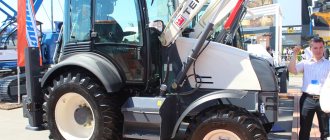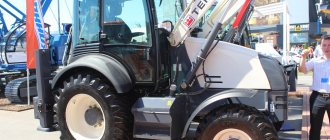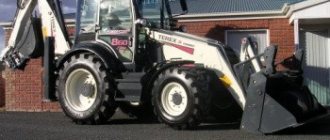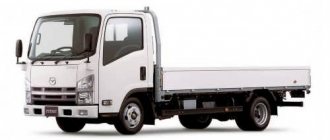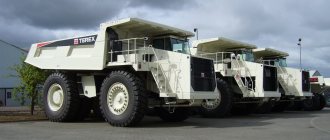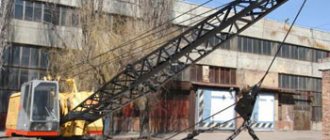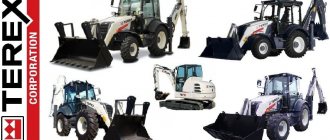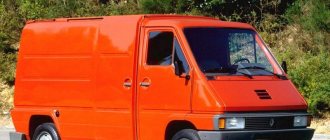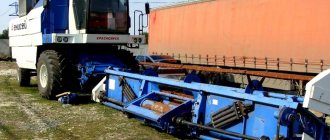Terex TLB 825 RM is a high-performance backhoe loader designed for a wide range of needs. The machine is adapted for a wide range of operations, and at the same time is very reliable, which is confirmed by numerous factory tests, as well as positive opinions from users. The 825 model ensures efficient operations that run smoothly, quickly and efficiently. At the same time, the machine still has high fuel efficiency, as well as low energy consumption of working parts. This loading device is manufactured using a modern technical process and meets all standards in terms of safety, ecology and efficiency. Let's consider its main features and characteristics, as well as the operating features and cost of this model.
Peculiarities
Compared to its predecessor, the TLB 825 backhoe loader has many distinctive features:
- Frame design with front axle balancer suspension
- Semi-rigid architecture at the rear
- Hydrostatic steering with emergency manual override
- Three braking modes: rear wheels only; all wheels in 2WD mode or all wheels in 4WD mode
- Simplicity and ease of operation
- Compact dimensions and high maneuverability, also due to the ability to brake simultaneously with one or two sides
- Possibility of installing off-road tires with extra deep tread for the best traction on the ground and other surfaces
- High efficiency of loading and unloading operations thanks to a technologically advanced metal boom with a unique drive, which ensures long service life and eliminates unscheduled maintenance
- The bucket is equipped with an automatic balancing system, thanks to which bulk materials do not spill out during transportation or loading and unloading operations
- The floating position of the boom provides convenience for planning areas and filling the working body when working on a flat surface
Terex TLB 825 is an example of modern multifunctional special equipment. Such a backhoe loader can effectively reduce labor costs compared to old Soviet technology. For intermittent use, it is rational to rent this type of equipment, since the purchase takes place only with constant use. For ease of selection, there are special exchanges, using Moscow as an example: https://birzha-sng.ru/moskva/arenda-spetstehniki/arenda-ekskavatora-pogruzchika
Fuel consumption when renting JCB JS200, JCB JS205 crawler excavators.
JCB JS200/JS205 crawler excavators also belong to the middle class of earthmoving equipment. Fuel consumption when working for rent is slightly higher than that of JCB wheeled excavators and also depends on the intensity and type of work.
Here are the main examples from our experience:
- when the excavator is loaded at about 70% of the work shift, the average diesel fuel consumption will be 11 l/hour;
- with active loading of excavators (digging pits and transferring soil), the average diesel fuel consumption will be 16 l/hour;
when working with a hydraulic hammer, the flow rate will be 10 l/hour.
Technical specifications
- Weight/carrying capacity – 7.71/3.46 tons
- Excavator bucket weight – 461.7 kg
- Front/rear bucket capacity – 1/0.25 m3.
- Speed (max) – 40 km/h
- Hydraulic flow rate, l/min – 142
- Maximum loading height – 3.343 m
- Maximum digging depth – 5.8 m
- Maximum bucket unloading height/digging axis offset – 3.58/1.28
- Breakout force indicator – 47.56 kN
- Turning radius – 7.2-8.4
- Dimensions, d/w/h – 7.28/2.34/2.81
- Ground clearance – 0.4 m
- Wheelbase volume – 2.13 m
- Fuel consumption – 14.7 l/h
How to calculate fuel consumption rate
The fuel consumption rate for forklifts is determined by the following formula:
Q = (N*q)/(1000*R*k), where
N is an indicator of the power of specific diesel engines, which is installed in a specific model for which the calculation is being carried out.
q is the nominal fuel consumption, which is specified in the relevant documentation for the engine.
R is an indicator of the density of the diesel fuel used. This parameter is known initially, according to the approved standard (840 kg/m3 for winter and 860 kg/m3 for summer). For convenience, the general indicator is set at 0.85 kg/dm3.
k is a certain coefficient that reflects the time period in percentage terms when the front loader was operated in normal mode and the amount of time when it was used at maximum crankshaft speed.
Engine
The Terex TLB 825 backhoe loader is equipped with a 4-cylinder Perkins 1104C-44T diesel engine with a volume of 4.4 liters and a power of 92 hp. With. Among the features of this internal combustion engine are direct fuel injection, liquid cooling and gas turbine charging with a charge air cooling function. The unit has a torque of 395 N/m, available already at 1350 rpm. The engine is adapted to the Tier 2 environmental standard. The 120-liter fuel tank, as well as the container for hydraulic fluid, have a durable steel body and are equipped with removable filter elements.
The hood cover of the Terex 825 excavator is a hinged type. In the open position, it is fixed on stops, which ensures safety and ease of maintenance.
Device, chassis and brakes
Elastic and durable plastic is used to make the wings of the Terex TLB 825 backhoe loader. The width of the wings exceeds the width of the chassis, which reduces the amount of dirt accumulation on the front wheels when driving on muddy dirt roads. The wing structure is mounted on shock absorbers and rotates with the wheels. This solution allows the wings to retain their original shape for a long time.
The gearbox is four-speed with servo drive. The gears are engaged quite smoothly, without noticeable jerks or jolts.
Thanks to its relatively compact dimensions, the loader has good maneuverability in small areas.
The loader axles are designed specifically to withstand harsh conditions. To strengthen them, planetary final drives are used in the wheel hubs. You can brake with the rear or all wheels, regardless of the mode (2WD or 4WD). The basis of the braking system is a dual-circuit mechanism and separate drive for the rear right and rear left wheels - in fact, this explains the presence of two brake pedals in the cabin. The brakes have a custom oil-type cooling system with a Kevlar coating.
Tires for the Terex TLB 825 loader are standard or optional for more severe conditions. In any case, excellent traction is ensured thanks to the relatively large rear wheels.
Working body and hydraulic system
The standard and telescopic handles of the Terex TLB 825 loader are characterized by high digging efficiency, regardless of the load. The standard work tool has forged eyes and is highly durable, while the telescopic boom has easy-to-clean guide eyes that are not subject to contamination, and the handle itself does not require lubrication.
Due to double-acting hydraulic cylinders, the power of the hydraulic system pumps reaches 142 liters during one minute of operation, and the operating pressure in the system is 225 bar.
Practical nuances
From the above information we see that almost all parameters when determining the fuel consumption of a forklift are known in advance, which cannot be said about the last coefficient (k).
To understand the situation, consider two examples:
- The equipment works at the railway station, loading and unloading railway cars. The shift is about 8 hours without a break. Workers are located on a platform that is located higher than the level of the special equipment, so the front loader forks do not rise to the height of the maximum boom reach. Maximum rotation of the engine crankshaft occurs only when the operator presses the pedal all the way, covering the distance between two certain points.
- The warehouse is open 24 hours a day. During the entire working day, there are two arrivals of trucks, which are unloaded in a few hours using the available equipment. It is at these moments that peak engine loads occur, but the rest of the time the crankshaft speed decreases, because the units perform warehouse work inside the warehouse without excessive intensity.
If we compare these two situations, then in the first case, the coefficient will be higher. This parameter takes into account peak loads - acceleration, downhill movement and lifting, during which the greatest use of equipment resources occurs. The calculation of fuel consumption for a front loader is determined based on the duration of its operation at peak crankshaft speeds from the total operating time (shift).
Salon and safety
The standard Terex TLB 825 backhoe loader cab is manufactured in accordance with current FOPS and ROPS safety standards. The shape of the glazing and the location of the body pillars have been carefully selected to best absorb the impact in the event of a rollover. Already in the basic configuration there is an adjustable seat with armrests and shock absorbers.
The steering wheel can also be adjusted, and the sound insulation of the cabin can be described as impeccable for this class. There is also a powerful heating system, sound and light alarms that are triggered in the event of an accident. In addition, you can also note the ergonomic arrangement of instruments and switches. For example, the steering wheel can be turned effortlessly with one hand thanks to the hydraulic booster and an additional handle, and the dashboard practically does not glare in the sun.
Specific examples
In order to have a rough idea of all the nuances of the calculation, we will determine the fuel consumption for Chinese forklifts. All information is taken from the data and technical parameters provided by the manufacturer, so there is no reason not to trust it. As for the coefficient (k), we will take the default indicator 2.3, based on the fact that the equipment operates at maximum speed for about 30% of the total operating time.
First, let's determine the fuel consumption for the Chinese SDLG LG936 loader with an engine power of 125 hp. With. The parameter specified by the manufacturer is 220 g/kWh. According to the formula, the norm will be as follows:
(125 * 220)/(1000 * 0.85 * 2.3) = 14 liters.
Now let's determine the fuel consumption for the XCMG ZL50G loader. Its engine power is 215 hp. With. Fuel consumption – 240 g/kWh. We count:
(215 * 240)/(1000 * 0.85 * 2.3) = 26 liters.
From these data it becomes obvious that the more powerful the engine, the higher the fuel consumption rate for the loader. Of course, real practice may differ significantly from the above theoretical calculations, because the specifics of the operation of Chinese loaders and other equipment may be different. The shift may last longer, the platform may be higher or lower, etc.
Another important nuance is the fact that a recently purchased unit that has not yet been properly run-in, as well as one that has a decent mileage, are all characterized by increased fuel consumption. In this case, it is necessary to carry out computational activities over several days of operation.
In the Beijing Auto online store you will find a large selection of spare parts for forklifts. The website contains a catalog that is regularly updated, so you can always find the necessary components for Chinese special equipment. A convenient search form by name and article number, as well as the ability to order missing parts directly from the manufacturer, allow us to satisfy the needs of a wide range of customers.
We are often asked the question, what is the fuel consumption of this or that road construction vehicle when operating on a construction site?
The rental company has various types of earthmoving equipment in its fleet, it is fully serviced and ready for rental.
We offer equipment for rent, and based on the customer’s tasks, we set the price:
- with diesel fuel. Our refueling mechanic regularly visits the site and performs maintenance and refueling of the equipment we rent;
- without diesel fuel. We often rent equipment from companies that have their own fleet of equipment already working on the construction site. It is profitable for them to rent an excavator at a much lower price and fill it with their own fuel.
Now let's figure out how the intensity and nature of work affects fuel consumption on different types of JCB excavators.
JCB JS330 crawler excavators belong to the class of heavy earthmoving equipment.
Diesel fuel consumption when renting such a machine can average 20 l/hour, when working with a hydraulic hammer - up to 18 l/hour.
From this article you can understand how fuel consumption can affect the cost of rent when ordering equipment. When renting JCB special equipment, the price without refueling with diesel fuel is significantly lower. The consumption of diesel fuel for different types of work, with different attachments and on different types of equipment is always different. Self-refueling of JCB DT excavators and loaders rented from AK SOKOL must be done only with high-quality diesel fuel with a low content of impurities and sulfur.
Home / Reference information
Determination of hourly fuel consumption of diesel engines
Hitachi Zaxis 3 series excavators
Hourly fuel consumption can be determined by the well-known relationship:
GT = (Ne * ge) / 1000, where:
GT — hourly fuel consumption (kg/hour);
Ne—effective engine power (kW);
ge—specific effective fuel consumption (g/kW*hour).
To obtain the hourly fuel consumption, expressed in liters per hour, it is necessary to divide the Gt value by the value of the density of the fuel used Pt, expressed in g/cm³. Taking into account the power utilization factor of an excavator diesel engine, the formula for determining the hourly consumption of diesel fuel, expressed in liters (Gtl), will finally take the following form:
Gtl = (Ne * ge * C) / 1000 * RT, where:
C is the diesel power utilization factor;
Pt is the density of the diesel fuel used (g/cm³).
Specific effective fuel consumption (ge)
The values of specific effective fuel consumption for each brand of diesel engine at a certain operating mode are presented in Table 1.
Note:
1. The sign (*) indicates data corresponding to the full load of the diesel engine;
2. For diesel engines of the 6WG1XYSA model range, the values of specific effective fuel consumption in practice will be higher by ≈ 5% due to the fact that the data given in the table does not take into account the power consumption for driving the cooling system fan.
Density of diesel fuel (Pt)
In accordance with GOST R 52368-2005 “EURO diesel fuel. Technical conditions for all classes, grades and types of diesel fuel are regulated by its density, determined at a temperature of 15 ºС and equal to 820 - 845 kg/m³. In this case, the lowest values apply to fuels used in winter, and the highest values apply to fuels used in summer.
Diesel power utilization factor (C)
The power utilization factor (C=1) is determined from the conditions for applying the maximum load. Actual fuel consumption depends on the machine model, modes and type of operation, the material being processed and, to a large extent, on the qualifications of the operator. Approximately coefficient C, depending on the type of work, is determined as follows:
C = 0.35 - 0.45 - relaxed operation of the machine, as a rule, this is work with light soils, loading work;
C = 0.45 - 0.60 - work related to digging soil and loading medium category soils;
C = 0.60 - 0.90 - work related to the development of heavy soils.
Hourly fuel consumption (Gtl)
The hourly consumption values (in liters) for the average density of diesel fuel Рт = 0.8325 g/cm³, depending on the power utilization factor for various diesel engines of excavators, are summarized in Table 2.
Note: the average density of diesel fuel is defined as the arithmetic mean of the lowest and highest values at an ambient temperature of 15º C.
Note: the average density of diesel fuel is defined as the arithmetic mean of the lowest and highest values at an ambient temperature of 15º C.
Hitachi equipment is widely used in road and construction work. Hitachi is a recognized world leader in the production of hydraulic excavators. Practice confirms: both heavy mining excavators and Hitachi mini-excavators have one of the best ratios of labor productivity per unit of cost. These are very powerful and reliable machines that have proven themselves well in Russian climatic conditions, including northern regions. During the operation of any special equipment, its individual parts periodically fail. But replacing these elements with similar branded spare parts does not pose any problem thanks to. Our company sells spare parts for special equipment from the world's leading brands. On our website in the catalog of spare parts for Hitachi excavators you will find replacement wheels, rollers, caterpillar tracks, bucket crown, side cutters, adapters, chains and many other necessary parts.
Your Hitachi excavator will not fail for a long time, thanks to the wide range of spare parts for excavators in the catalog and timely deliveries of these parts anywhere in Russia.
Magazine "Agrotechnics and Technologies"
March – April 2008
Read issue
Gennady Ryazanov, general director of the Ago farm (Tyumen region):
— To work using no-till technology, we needed a tractor that could easily be combined with a 12-meter seeder, so a John Deere 8430 with an engine power of 320 hp. With. was perfect for us.
Under 24-hour operation conditions, this model, aggregated with a seeder, sows 120 hectares, and with a Rubin-type disc cultivator it cultivates 180 hectares. At the same time, fuel consumption is only 8 l/ha.
Unlike the Kirovets K700, which we used previously, the John Deere 8430 is perfectly balanced. During the summer season, we cultivated 40 thousand hectares, the unit worked 3 thousand operating hours - this is a very good indicator. The productivity of this model is 1.5-2 times greater than that of the Kirovets. Moreover, there were no serious breakdowns (except for a malfunction of the fluid coupling), so the unit was not idle.
At times we had difficulties with the supply of spare parts for this tractor. However, this problem occurs not only with John Deere, but also with other foreign manufacturers, such as LANDINI or Case New Holland.
Nikolay Solovyov, chief engineer of JSC Predportovy (Leningrad region):
— On our farm, we replaced the old fleet consisting of Belarusian MTZ machines with new John Deere tractors. We bought one of them - model 8430 of the eighth series - last year. It is easily aggregated with other agricultural machines. For example, having a front linkage, you can use an additional mower or some other unit (cultivator, seeder) and thus perform two operations in one pass.
The 8430 tractor is 100% loaded all year round: almost the entire list of machines needed on the farm has been selected to work with it. In 2007, we made silage on it throughout the entire season. In winter, the unit worked with a 17-ton trailer, transporting organic matter (peat, manure) to the fields. This equipment also showed itself well in sowing grain crops: equipped with a nine-meter Soliter seeder (Lemken), depending on weather conditions, it covered up to 22 hectares per shift. There were no serious breakdowns during operation. There were, of course, minor malfunctions (the filter was clogged), but they dealt with them on their own.
One of the criteria due to which we chose this model is a nearby service center (Leningrad region; supply of agricultural machinery for crop production from European manufacturers). We are confident that in the event of a serious breakdown, the specialists working there will be able to respond promptly and protect us from equipment downtime.
The disadvantages of the John Deere 8430 include the difficulty of working on Russian diesel fuel. In winter (when the temperature dropped to -12-15°C), when using low-quality fuel, paraffin precipitated and clogged the filters, causing the tractor to stall. In order for the machine to work properly, we had to install additional separators.
Viktor Ivanov, chief engineer of Plemzavod Prinevskoye CJSC (Leningrad region):
— Initially, we worked on the Kirovets K700, but all the units (seeder, ridge former, etc.) that we planned to purchase could not be combined with this tractor due to its poor hydraulics.
In the spring of 2007, we bought a John Deere 8430. The first reason why we chose this model was its low cost (6 million rubles). After all, other Western analogues are 5-10% more expensive than this tractor.
During the season, the machine worked 1.2 thousand engine hours, cultivating 4.5 thousand hectares of arable land. During this time, no serious breakdowns occurred. The service center has never disrupted the supply of components for maintenance, which our specialists carried out independently.
In my opinion, it is not advisable to buy a John Deere 8430 tractor for small farms with an arable area of less than 1 hectare. The fact is that this machine is a powerful power source, and in order to load it, you need to have quite expensive trailed and attached equipment.
Expert opinion
Nikolai Shcheltsyn, director of the Scientific Research Tractor Institute (NATI):
— As a rule, farmers purchase John Deere 8430 due to the lack of domestic analogues designed to perform energy-intensive technological operations. But, as far as I know, developments to create such tractors are currently underway in Minsk. These machines should enter our market approximately in 2008-2009. And in Russia, the production of models of the same class begins “twinned” with the Petersburg Tractor Plant (St. Petersburg). Despite the fact that the cars of this manufacturer consist exclusively of imported components, the company will be able to gain a certain market share.
At the same time, among foreign equipment there are quite a lot of analogues of the John Deere 8430 model. Almost all Western companies have units of similar power (from 250 to 350 hp). But the 8430 is popular due to its price - it is 15-20% cheaper than the cost of some other imported tractors (for example, Fendt machines) - and quality.
Due to its high power, this model is in demand among large farms that have large fields and are interested in purchasing powerful equipment. High-performance complexes can be easily assembled with this machine.
This model is quite reliable and breakdowns are rare. If the John Deere 8430 operates for about 1.5 thousand hours/year, then it can last at least 10-15 years. The question is how quickly the service center will respond in case of problems. But, as I know, in Russia the John Deere service network is quite well developed.
Valery Adaev, General Director:
— If you do not take into account the 8530 model, which differs from other eighth series tractors in the presence of a front axle with independent suspension, then the 8430 unit is the last in the line of John Deere machines with an unbreakable frame. Next comes a series of more powerful tractors (380-500 hp) with a breakable frame. They are 30-40% more expensive than their predecessors (without a breaking frame, the estimated cost of units is 0-220 thousand, and with a breaking frame - 0-290 thousand).
In my opinion, a tractor with a power of 300-330 hp is more versatile. With. It can be used for various types of agricultural work (plowing, cultivation, harrowing, sowing, transport work, work with trailed forage harvesting machines, etc.), and due to the large load, it has a shorter payback period.
The main competitors of the 8430 can be considered the New Holland T 8040 and Case Magnum M X 300. These units also have a rigid frame, have the same traction force, but are 15-20% cheaper. As a result, CNH tractors have a leading position in terms of sales in Russia, and John Deere takes second place.
The 8430 tractor is more suitable for large farms. On average, one unit is designed for 1.5-2 thousand hectares of land and, at maximum full load, will pay for itself in 2-3 years. A machine of this class, with a normal approach, is capable of operating 15 thousand hours before the first major overhaul. The main condition for high-quality operation of this model is the use of diesel fuel and good quality oil. Quite often, farmers fill their vehicles under warranty with original oils recommended by the manufacturer, and as soon as the tractor comes out of warranty, wanting to save money, they fill it with a surrogate, which results in problems.
Like any other equipment, the model 8430 tractor is not immune to minor factory defects. For example, in the first days of operation the sensor may fail. But by and large, the nature of breakdowns in this model is not as serious as, for example, in Russian equipment. A qualified specialist is able to cope with a minor problem, unless it is a serious manufacturing defect, the elimination of which is solely within the competence of the service center of the manufacturer's dealer.
However, the service offered by most John Deere dealers, in my opinion, is of a low level. This problem is common to many Western companies offering their equipment to the Russian market.
Attachments
The Terex TLB 825 backhoe loader comes standard with a hydraulic hammer, auger, forks and a road brush. Equipment can be changed automatically without having to leave the cab. In addition, another convenience is the presence of a universal connector that allows you to install third-party equipment from other companies. Instead of an automatic system, a conventional mechanical method for replacing working tools is also provided. In both cases, the productivity of the Terex 825 with attachments increases significantly due to the ease of changing working tools.
The TLB 825 backhoe loader is also equipped with the following types of buckets:
Loading
- Standard - has a width of 2.24 m and a volume of 1 cubic meter. m. Weight 460 kg, pull-out force 47.5 kN
- 2.7 in 1 – can act as a bulldozer or a load-lifting crane with a permissible weight of up to 1 ton. The working height of such a bucket is 4.3 m, and the maximum force is 47.5 kN
Fuel consumption when renting a JCB JS330 crawler excavator.
JCB JS330 crawler excavators belong to the class of heavy earthmoving equipment.
Diesel fuel consumption when renting such a machine can average 20 l/hour, when working with a hydraulic hammer - up to 18 l/hour.
From this article you can understand how fuel consumption can affect the cost of rent when ordering equipment. When renting JCB special equipment, the price without refueling with diesel fuel is significantly lower. The consumption of diesel fuel for different types of work, with different attachments and on different types of equipment is always different. Self-refueling of JCB DT excavators and loaders rented from AK SOKOL must be done only with high-quality diesel fuel with a low content of impurities and sulfur.
30.08.2018
As statistics show, the Russian forklift market is dominated by models with internal combustion engines, which are significantly larger than their counterparts that run on electricity. This equipment is operated in harsh conditions that require large resources. That is why one of the most important parameters to pay attention to is the fuel consumption of the forklift.
The cost of goods and work performed is directly calculated based on the fuel and lubricants used. The problem is that the fuel consumption of front loaders is much more difficult to determine than for a conventional vehicle, because for this equipment there is no defined standard for a range of 100 km.
